Bachem Natter BP-20
Mustermachine 22/23

Brengun, 1/72 scale
S u m m a r y : |
Catalogue Number: |
Brengun Kit No. BRP72015 – Bachem Natter BP-20 Mustermachine 22/23 |
Scale: |
1/72 |
Contents & Media: |
One clear and 39 tan styrene parts, two resin parts, one PE fret of six parts, and decals for two aircraft. |
Price: |
Available on-line from these stockist:
For currency conversion click here |
Review Type: |
First Look. |
Advantages: |
Improved moulding quality and fit over the 2012 original, due I think to adoption of metal tooling. Enables only manned and powered airframe to be built. |
Disadvantages: |
None noted. |
Conclusion: |
Brengun have made the best Natter in “The One True Scale” even better by re-tooling with a metal mould. I am also pleased that they have provided a new fuselage and tailfin with this boxing that enables airframe M23 to be built, the only one used in a manned powered flight. I definitely recommend it. |
Reviewed by
Mark Davies

Sword's 1/72 scale Ki 44 Shoki is available online from
Squadron.com
The Ba 349 Natter was a last ditch attempt by the Germans to challenge the daylight bomber raids that were pulverising their home territory. Two of the harder tasks that a pilot must master are landing and take-off, but Germany lacked time and resources to train pilots as the war neared its end. The attraction of the Natter was that it did away with the need for the pilot to control take-off or indeed land the plane. Armed with a battery of air-to-air rockets, it could take off vertically to attack a bomber formation. An autopilot controlled the Natter’s launch and approach to target, whilst a hastily trained SS pilot controlled the attack phase of the flight.
The Natter used the same liquid fuel rocket engine the Me 163 Komet. It also had four solid fuel boosters used for take-off that were jettisoned after they burned out. The Natter was to launch as a bomber formation neared its base and climb above the enemy, whereupon it would attack in a dive much as the Komet did. It would them engage the bombers with its battery of twenty-four R4M rockets that were fired off in one go. These same 73-mm rockets had proved very effective when used by the Me 262 that carried them on underwing pallets.
Some of the Komet’s operational problems would have applied to the Natter as well. It would have had similar issues with refuelling risks, short fuel supply and high closing speeds. Both planes were point-defence interceptors, but the Natter had the distinct advantage of not needing an airfield. The Allied bombers used flight paths that avoided known Komet airfields. This would be much harder to do with Natters launched vertically from hidden sites.
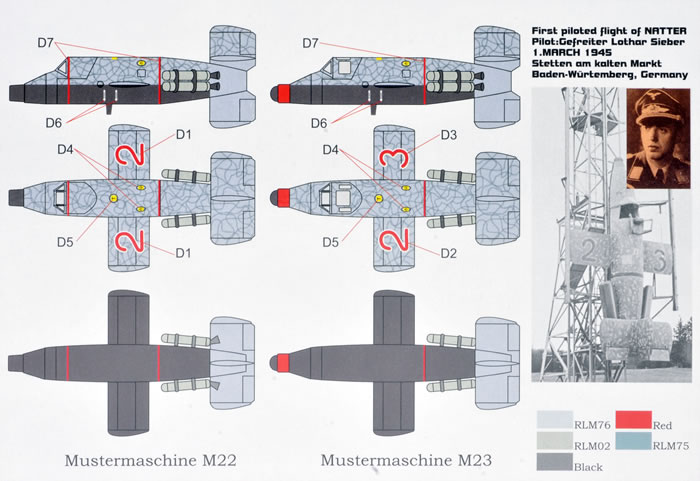
The Natter then descended rather like a brick with wings to somewhere that was hopefully near to its base. In fact, the Natter proved to be quite controllable during an untethered gliding test flight, albeit with a very steep glide angle. The cockpit and nose would then separate from the fuselage. This process expelled the pilot shortly thereafter, who would land using his parachute. There was to be a parachute recovery of the rocket motor and the remaining airframe as well. However, the impact of landing caused small amounts of unused fuel to explode and so destroy the motor and airframe. The wooden airframe was simple to make and therefore expendable. The rocket motor consumed more resources to build, but its loss had to be accepted too.
Bachem built thirty-six Natter BP-20 prototypes, and possibly a handful of production aircraft that were designated as Ba 349’s. All flights involved prototypes, of which unmanned take-offs consumed eighteen. A pilot successfully bailed out during an unpowered test flight when the nose separated from the airframe, which at least proved that the escape system worked. Another Natter crashed following a towed gliding flight (it had a crude fixed tricycle undercarriage). The single attempt at a manned take-off killed the test pilot when the Natter went out of control early in its take-off. Around fourteen finished and thirty incomplete Natters may have existed at the war’s end. Three versions were planned, these being the Ba 349A, B and C; sometimes referred to as the Mk.I, II and III respectively. Four Ba 349B airframes were found at the war’s end.
The Ba 349A had a battery of twenty-four Hs 217 73mm unguided rockets (although one instead used thirty-two tubes armed with 30mmm shells!); whilst the Ba 349 B & C were to be armed with thirty-two R4M 55mm unguided rockets and two Mk108 30mm cannon under the cockpit floor. The B also had a slightly longer fuselage (300mm/12”) and its booster-rockets were mounted further back on the fuselage compared to the A. The wings of the Ba 349C were to have been removable to aid transportation; being inserted through the fuselage and secured by bolts, and mounted further back than on the A and B variants. The C’s tail was also different, as it was to have been mounted on top of the fin.
It seems fair to say that the Natter was not exactly a standout success for Jerry then, but bally clever chaps all the same; wouldn’t you say?
Previous 1/72-Scale Natter Kits
I am aware of three previous Natters in the one true scale other than Brengun’s. For many years the best known and the best kit was by Heller. It came boxed with the manned version of the Fi 103 V-1 flying bomb. Crisply moulded, with very fine and restrained raised surface detail, the Heller kit is a rare find these days. I once owned the Heller kit and a simple and rather crude resin Natter kit by AV Models. I am also aware of a vac-form kit by Airmodel with which I am unfamiliar.
Of course Brengun has led the 1/72 scale Natter-scene since their release of a new limited run tooling in mid-2012, which I took ‘first look’ at here on HyperScale, and a “What If?” boxing of the same kit in early 2013; which I also reviewed here on HyperScale.
Contents
The kit comes in an end-opening box with digital artwork. The instructions have a parts map and use a diagrammatic format that is easy to follow. There are no written instructions, but then none are required, so simple is this kit. Paint colours are in Czech and English, and cross-referenced to RLM codes where applicable. The painting and decal guide consists of coloured three-view illustrations on the rear of the box. The parts come enclosed in a zip-lock bag, with the clear and PE parts further enclosed in a small bag of their own.
The Ba 349 was Brengun’s first injected kit, and whilst the shared common sprue’s layout is the same as before, this release is, I am sure, from a new tool. The new release is noticeably crisper, virtually flash-free, has smaller sprue gates and the clear canopy far clearer. There are also new small locating lugs and corresponding holes on some parts that were not there before, as well as wings that insert into slots rather than butt-fit against the fuselage. I think a change has been made from a resin to metal tooling. Another change is the addition of two taller resin end-frames to the ‘wooden’ trestle for the model to sit on, these being flawlessly cast.
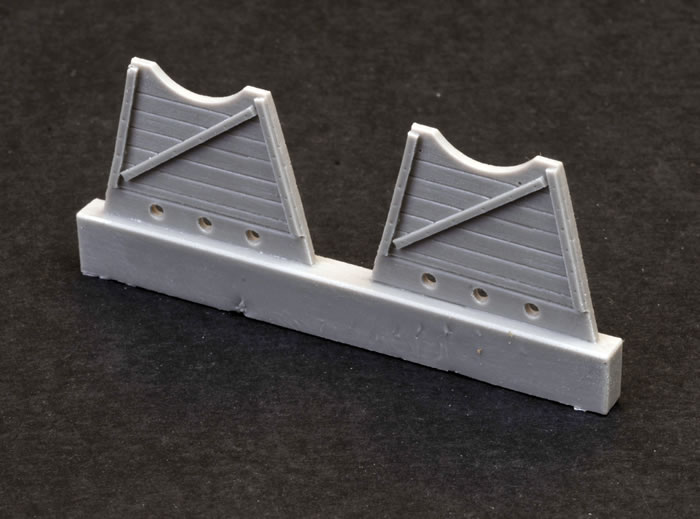
This boxing has a second sprue with new fuselage halves, nose cones and ventral tailfin. This is because this issue represents airframes M22 & M23, both prototypes, which had different nose cones and ventral tailfin to the earlier kit’s Ba 349A style. The M23 was the only airframe to make manned and powered launch, but crashed killing the pilot shortly after take-off.
The Kit
Assembly of the kit is straightforward. It starts with the cockpit interior that includes seat, PE belts, control column, rudder bar, instrument panel, floor, and rear bulkhead. However, not much is visible through the canopy’s small clear panels.
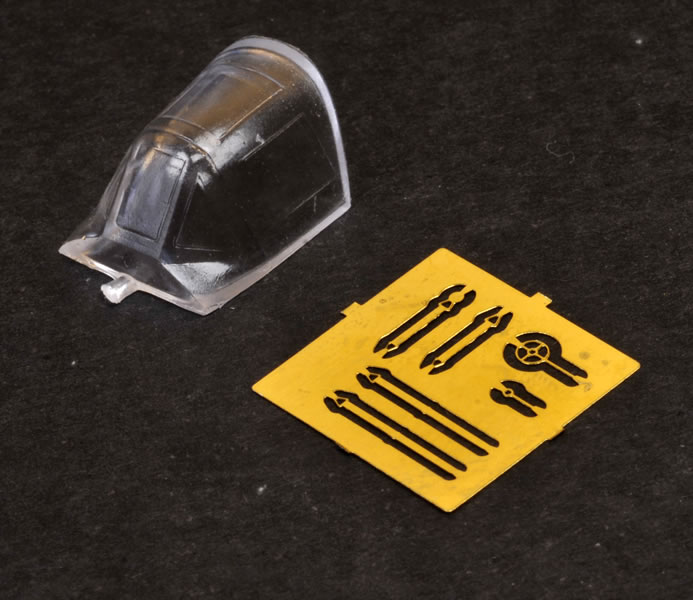
The cockpit sub-assembly and main engine exhaust fit within the fuselage before closing the two halves. There is choice of nosecones to cover a minor difference in appearance between the two prototypes. Another small difference between the two is that M22 had only a windscreen with solid canopy. The instructions advise to fill the recessed outlines of the small clear canopy to account for this. The tiny wings fit into recesses within the fuselage. The horizontal stabiliser sits on top of the fin’s base, after which the remainder of the fin fits in place, whilst a ventral fin fits to the fuselage’s underside.
The four booster rockets come in two pairs with separate exhaust nozzles. The exhaust nozzles are in two parts to enable them to have hollowed out centres. A one-piece canopy and PE ring & bead sight completes the airframe assembly. The kit also provides a wooden trestle (the ends of which are resin parts) to sit the completed model on. This is not a gimmick but based on photos of the real thing.
Overall, I think this should be a simple and even more enjoyable kit to build than the original Brengun release thanks to improved tooling. Here is an image of the completed kit courtesy of Brengun:
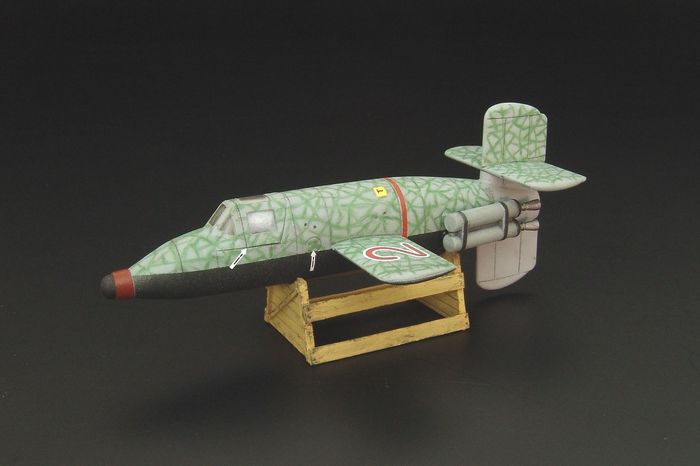
Marking Options
The kit offers two colour scheme options. One is for airframe M22, which was used in an unmanned powered launch to test the parachute system. The other is M23, the only machine to be manned for a powered launch and flight. It was briefly flown and crashed by Gefreiter Lothar Sieber on March 1st, 1945 at Stetten am Kalten Markt, Baden-Wurtemberg, Germany. Of small photo of M23 on its launch gantry with an inset image of Gefreiter Sieber is included on the rear of the box.
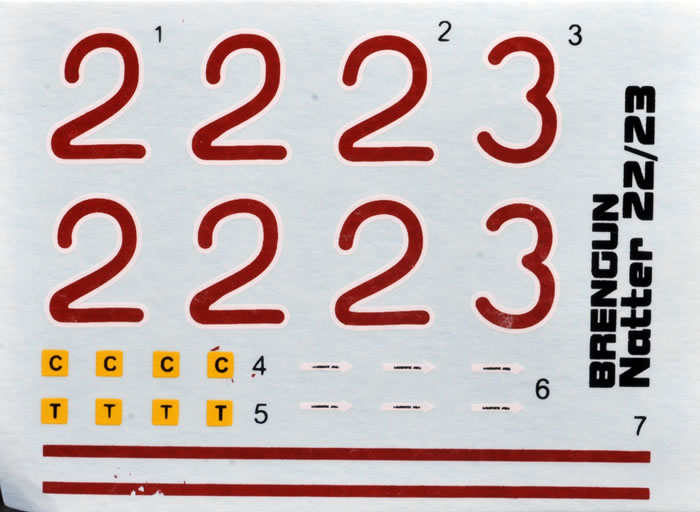
Both machines feature quite dense RLM75 squiggle camouflage over RLM 76 upper surfaces, and predominantly black under-surfaces. Booster rockets are RLM02, and M23 has a red band around the nose. Both have large numerals in red with white outline reflecting their airframe number, with one digit per wing.
The small decal sheet appears to be of god quality, and aside from the airframe numbers, includes fuel designator and arrow stencilling, plus two red stripes.
Brengun have made the best Natter in “The One True Scale” even better by re-tooling with a metal mould. I am also pleased that they have provided a new fuselage and tailfin with this boxing that enables airframe M23 to be built, the only one used in a manned powered flight.
I definitely recommend it.
Thanks to Brengun for the review sample.
Review Text & Blue Background Images Copyright © 2015 by Mark Davies
Page Created 20 October, 2015
Last updated
20 October, 2015
Back to HyperScale Main Page

|
